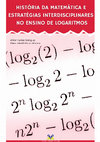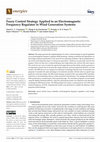Papers by Elmer Rolando Llanos Villarreal

Editora Conhecimento Livre eBooks, Dec 31, 2022
Da gênese da invenção à formulação conceitual dos logaritmos 1 NOTA INICIAL Este capítulo trata d... more Da gênese da invenção à formulação conceitual dos logaritmos 1 NOTA INICIAL Este capítulo trata de uma descrição histórico-analítica sobre a formulação conceitual dos logaritmos com vistas a ampliar e complementar os estudos sobre o tema, que podem estar presentes nos livros didáticos do Ensino Médio. Neste sentido, interpretamos que a descrição apresentada poderá contribuir para fundamentar o trabalho do professor de Matemática no que diz respeito à abordagem conceitual do assunto em sala de aula, tendo como foco o desenvolvimento histórico-conceitual, que sugere esclarecimentos acerca da gênese e dos processos operacionais que envolvem os logaritmos e suas interconexões com outros campos da Matemática, em seu sentido transversalizante e interdisciplinar, que tem implicações na efetivação de uma aprendizagem compreensiva deste assunto.

This article provides insight into flow measurement techniques in water injection wells in oil pr... more This article provides insight into flow measurement techniques in water injection wells in oil production fields, with a particular focus on the initial phases of operation. Consequently, the method created by Ramey in 1962, originally intended for estimating the temperature of the injection fluid, has been adapted to calculate the flow rate. In this technique, the calculation This procedure is based on the correlation between the thermal flux formed in the well. The discrepancy between the temperatures of the injected liquid and the geothermal temperature of the reservoir is the main source of the systematic errors in Ramey’s technique. To a lesser extent, but still significant, failure to observe the injection time in a fluid variation also results in an error problem that needs the failure to adhere to the scheduled injection time for a fluid alteration also yields a notable error dilemma that needs to be fixed. The reduction of listed systematic errors is the product of the main...
This paper has the objective of implementing the radial rotor position control of a three-phase b... more This paper has the objective of implementing the radial rotor position control of a three-phase bearingless induction machine with split winding and optimized drive structure, using the ADRC technique. Because it is a multivariable, nonlinear, time-varying system with coupled variables, it is necessary to use advanced control strategies in order for the system to operate efficiently and with good dynamic performance. The ADRC controller considers the total disturbance composed of unmodeled dynamics, nonlinearities, uncertainties, and load variations, as a new system state, to be estimated in real-time through an extended state observer. In this mode, disturbances are compensated in real-time, eliminating regime errors and with good response to disturbances in general.
2022 IEEE International Conference on Automation/XXV Congress of the Chilean Association of Automatic Control (ICA-ACCA)
Proceeding Series of the Brazilian Society of Computational and Applied Mathematics
Active suspension systems for the vehicle control problem are formulated using output feedback. T... more Active suspension systems for the vehicle control problem are formulated using output feedback. The present article proposes solving the output feedback control with eigenvalues for active suspension systems using Sylvester equations. The matrices are prescribed in advance and depend greatly on the controllability conditions, being assigned the system's observability eigenvalues. The theorems were presented using Sylvester equations. The algorithm was implemented based on Sylvester equation, and an example was presented with their conclusions.

Energies
This paper presents the implementation of a fuzzy control strategy for speed regulation of an ele... more This paper presents the implementation of a fuzzy control strategy for speed regulation of an electromagnetic frequency regulator (EFR) prototype, aiming to eliminate the dependence on knowledge of physical parameters in the most diverse operating conditions. Speed multiplication is one of the most important steps in wind power generation. Gearboxes are generally used for this purpose. However, they have a reduced lifespan and a high failure rate, and are still noise sources. The search for new ways to match the speed (and torque) between the turbine and the generator is an important research area to increase the energy, financial, and environmental efficiency of wind systems. The EFR device is an example of an alternative technology that this team of researchers has proposed. It considers the main advantages of an induction machine with the rotor in a squirrel cage positively. In the first studies, the EFR control strategy consisted of the conventional PID controllers, which have s...

This paper presents the implementation of a control strategy based on fuzzy logic artificial inte... more This paper presents the implementation of a control strategy based on fuzzy logic artificial intelligence (AI) for speed regulation of an electromagnetic frequency regulator (EFR) prototype, aiming to eliminate the dependence on knowledge of physical parameters in the most diverse operating conditions. Speed multiplication is one of the most important steps in power generation wind. Gearboxes are generally used for this purpose. However, they have a reduced lifespan and a high failure rate and are still noise sources. The search for new ways to match the speed (and torque) between the turbine and the generator is an important research area to increase the energy, financial and environmental efficiency of wind systems. The EFR device is an example of an alternative technology that this team of researchers has proposed. It counts the fact of taking advantage of the main advantages of an induction machine with the rotor in a squirrel cage positively. In the first studies, the EFR contr...

2021 IEEE International Conference on Automation/XXIV Congress of the Chilean Association of Automatic Control (ICA-ACCA)
The article considers an approach for partial eigenvalue assignment in singular second order syst... more The article considers an approach for partial eigenvalue assignment in singular second order systems via proportional controller plus derived control plus output feedback controller. It is shown that the problem is closely related to a so-called second-order Sylvester matrix equation. This study presents an approach to partial the eigenstructure assignment for the descriptor system where an algorithm is presented for calculated the output feedback matrix by Sylvester equation. The paper is proposed two complete parametric methods for an approach to partial eigenstructure assignment problems. Both methods are respectively given simples complete parametric expressions for feedback gains and the closed-loop eigenvector matrices. The first one mainly depends on a series of singular value decompositions. The second one utilizes methodology for the system's factorization and enables the closed-loop eigenvalues to be set undetermined and search via specific optimization procedures. The theorems are presented using the Sylvester equations. Two algorithms are implemented using the Sylvester equation, and examples are presented with their conclusions.

2021 IEEE International Conference on Automation/XXIV Congress of the Chilean Association of Automatic Control (ICA-ACCA), 2021
This paper is presented a new approach to fuzzy active-disturbance rejection position controller ... more This paper is presented a new approach to fuzzy active-disturbance rejection position controller of the bearingless induction machine (BIM) servo system. The paper deals with applying the Fuzzy technique of Active Disturbance Rejection Control (ADRC) in stabilizing and controlling the radial position rotor of a bearingless induction machine with split winding. A new control variable for the radial position problem is a proposition in the article, and the variable ADRC-Fuzzy control is using to improved dynamics of the closed-loop system when a load modification happens at the output. The simulation computational show that control stabilizes the plant and rejects disturbances. These results served as the basis for future experimental validation in the problem.
2020 IEEE XXVII International Conference on Electronics, Electrical Engineering and Computing (INTERCON), 2020
This work investigates the application of the Active Disturbance Rejection Control (ADRC) techniq... more This work investigates the application of the Active Disturbance Rejection Control (ADRC) technique on the stabilization and control of the rotor radial position of a bearingless induction machine with split winding. A control model for the radial position problem is proposed and the ADRC is used aiming to improve the closed-loop system dynamic when a change load occurs on the output. The simulations showed that the controller is able to stabilize the plant and reject disturbances. These results will guide to a future experimental validation of the problem.
PRZEGLĄD ELEKTROTECHNICZNY, 2019
In this paper, an analysis of electrical parameters of a 2036 m ESP three-phase power cable and r... more In this paper, an analysis of electrical parameters of a 2036 m ESP three-phase power cable and round profile has been carried out. This analysis will provide subsidies to electrically model the channel through which the data will be transmitted from downhole to the surface. A printed circuit board was developed through the correct grouping of passive electronic components to represent the same impedance and phase behavior of the measured ESP power cable for a frequency range from 20 Hz to 200 kHz. Streszczenie. W artykule nalizowany jest system komunikacji w zanurzeniowej pompie zasilanej napieciem trójfazowy za pośrednictwem kabla. Ten sam kabel jest też wykorzystywany do przesyłania sygnałów z czujników. Model elektryczny pompy zanurzeniowej w której kabel zasilający wykorzystywany jest do komunikacji.
2015 Workshop on Research, Education and Development of Unmanned Aerial Systems (RED-UAS), 2015
The paper presents a brief study of quadrotor vehicle, its principle of operation and its high-le... more The paper presents a brief study of quadrotor vehicle, its principle of operation and its high-level dynamic model. The proposal of altitude and yaw controllers is also presented. PID, LQR (LQRI) and Lyapunov based control techniques are here compared according to Integral Absolute Error (IAE) and Control Signal Energy criteria. The performance is analyzed in terms of the response time and energy spent to accomplish the task. The optimum controller gains are defined by simulation, after establishing the maximum value of the criteria. In the sequence, some experiments are run to validate the controllers and to compared them in real scenarios of regulation and trajectory tracking tasks.

Sensors, Nov 27, 2023
This article presents an analytical solution for calculating the flow rate in water injection wel... more This article presents an analytical solution for calculating the flow rate in water injection wells based on the established thermal profile along the tubing. The intent is to minimize the intrinsic systematic error of classic quasi-static methodologies, which assume that all thermal transience on well completion has passed. When these techniques are applied during the initial hours of injection well operation, it can result in errors higher than 20%. To solve this limitation, the first law of thermodynamics was used to define a mathematical model and a thermal profile was established in the injection fluid, captured by using distributed temperature systems (DTSs) installed inside the tubing. The geothermal profile was also established naturally by a thermal source in the earth to determine the thermal gradient. A computational simulation of the injection well was developed to validate the mathematical solution. The simulation intended to generate the fluid's thermal profile, for which data were not available for the desired time period. As a result, at the cost of greater complexity, the systematic error dropped to values below 1% in the first two hours of well operation, as seen throughout this document. The code was developed in Phyton, version 1.7.0., from Anaconda Navigator.

Energies
The electromagnetic frequency regulator (EFR) device has proven to be an attractive solution for ... more The electromagnetic frequency regulator (EFR) device has proven to be an attractive solution for driving grid-connected electrical generators in distributed generation (DG) systems based on renewable energy sources (RES). However, the dynamic characteristic of the EFR has not yet been discussed for cases where its parameters vary from the nominal values. To evaluate this issue, this paper proposes a method for transient and steady-state performance analysis applied to the EFR device considering parametric variations. To perform this analysis, a dynamic model of the EFR device is derived, and its dynamic characteristics are discussed. Based on this model, the system’s controller gains are designed by using the root-locus method (RLM) to obtain the desired dynamic performance. Then, a sensitivity analysis of the closed-loop poles under the effect of parameters variation is performed. In addition, the paper also presents an analysis of the EFR-based system operating with the designed c...
Collection: Applied computer engineering, 2022

2021 IEEE International Conference on Automation/XXIV Congress of the Chilean Association of Automatic Control (ICA-ACCA), 2021
The article considers approaches to partial eigenvalue assignment in second order descriptor syst... more The article considers approaches to partial eigenvalue assignment in second order descriptor systems using proportional plus derivative plus output feedback controller. The impulse elimination approach by output feedback control is addressed by combining the eigenstructure and the closed-loop system's finite eigenstructure. With a base in the desired eigenstructure, the gains controller's parametric formulations doing the closed-loop system impulse-free and assigning the finite eigenstructure are referred. The computational simulation result is provided to verify the effectiveness of the proposed method. This study presents an approach to partial eigenvalue assignment for the descriptor system where an algorithm is presented for calculated the output feedback matrix by the Sylvester equation. Sylvester equations present the theorems. Two algorithms are implemented using the Sylvester equation, and examples were presented with finally their conclusions.
Energies, 2021
In order to reduce the costs of implementing the radial position control system of a three-phase ... more In order to reduce the costs of implementing the radial position control system of a three-phase bearingless machine with split winding, this article proposes a driving method that uses only two phases of the system instead of the three-phase traditional one. It reduces from six to four the number of inverter legs, drivers, sensors, and current controllers necessary to drive and control the system. To justify the proposal, this new power and control configuration was applied to a 250 W machine controlled by a digital signal processor (DSP). The results obtained demonstrated that it is possible to carry out the radial position control through two phases, without loss of performance in relation to the conventional three-phase drive and control system.










Uploads
Papers by Elmer Rolando Llanos Villarreal